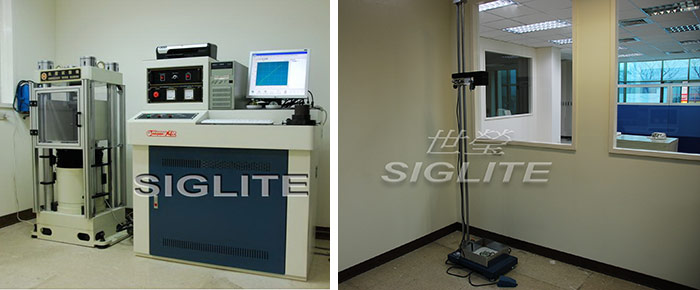Test method
How to differentiate a good glass road marker?
Compressive strength
The compressive strength must reach above 40 tons.
Test method:
First, to install the specimen on the tester base with a piece of newspaper folded into five. Then, to coincide both the center of the steel bar (min. diameter 25mm, min. thickness 10mm) and the convex part of the specimen. To avoid the vibration during the testing process, so increase loading slowly, the rate of loading increase is maintain 49~68.6kn/min (5,000~7,000kgf/min). At last, the loading increases to 392.0kN (40,000kgf).
Product evaluation: The minimum loading criterion is 392.0kN (40,000kgf)
Ball-Impact test
After the impact, there must not be any damage or visible crack on the glass material.
Test method:
Place sample in middle of cushion, which is 3mm*150mm*150mm, or 150mm in diameter and 50 IRHD in hardness. Place the steel ball (Rolling Ball), 63.5mm in diameter (1,040g) higher than the sample for 150cm. Release the ball to impact the hemispheric part of sample. Check the condition of damage. (Use methylbenzene to wipe and clean before test).
Furnace test
Test method:
Put the glass marker into furnace at 500 centigrade for 3 minutes and then take out for observation, the reflective film or protecting layer at base is not burnt, the color is not changed and the glass shows no abnormal situation.
Most products that cannot pass this test are imitations with dye or paint at bottom, where the color normally starts to fade after half a year on the road surface and losses reflecting ability. The bottom reflector shall be coat by aluminum thermal spray process. The bottom will be thicker and more durable; the lifetime can be more than 10 years. The China products use the electroplating process on the surface of the bottom part. The process is electroplating a slight aluminum layer first, than coat a layer made of paint and sand on the surface. It will be look like coat by aluminum thermal spray process, but the aluminum reflector of the electroplate product will start to fade after half or one year on the highway system.

The compressive strength must reach above 40 tons.
Test method:
First, to install the specimen on the tester base with a piece of newspaper folded into five. Then, to coincide both the center of the steel bar (min. diameter 25mm, min. thickness 10mm) and the convex part of the specimen. To avoid the vibration during the testing process, so increase loading slowly, the rate of loading increase is maintain 49~68.6kn/min (5,000~7,000kgf/min). At last, the loading increases to 392.0kN (40,000kgf).
Product evaluation: The minimum loading criterion is 392.0kN (40,000kgf)
Ball-Impact test
After the impact, there must not be any damage or visible crack on the glass material.
Test method:
Place sample in middle of cushion, which is 3mm*150mm*150mm, or 150mm in diameter and 50 IRHD in hardness. Place the steel ball (Rolling Ball), 63.5mm in diameter (1,040g) higher than the sample for 150cm. Release the ball to impact the hemispheric part of sample. Check the condition of damage. (Use methylbenzene to wipe and clean before test).
Furnace test
Test method:
Put the glass marker into furnace at 500 centigrade for 3 minutes and then take out for observation, the reflective film or protecting layer at base is not burnt, the color is not changed and the glass shows no abnormal situation.
Most products that cannot pass this test are imitations with dye or paint at bottom, where the color normally starts to fade after half a year on the road surface and losses reflecting ability. The bottom reflector shall be coat by aluminum thermal spray process. The bottom will be thicker and more durable; the lifetime can be more than 10 years. The China products use the electroplating process on the surface of the bottom part. The process is electroplating a slight aluminum layer first, than coat a layer made of paint and sand on the surface. It will be look like coat by aluminum thermal spray process, but the aluminum reflector of the electroplate product will start to fade after half or one year on the highway system.


